#Ereškigal deity
Text
Ereškigal in Ancient Literature
*How to use the Internet Archive
🥀 Main Character 🥀
Earlier version of The Myth of Nergal & Ereškigal is available in the paper: New Readings in the Amarna Versions of Adapa and Nergal and Ereshkigal by Shlomo Izre'el.
The later version of the Myth of Nergal & Ereškigal, as well as a version of Ištar's Descent Into The Netherworld are both available in The Ancient Near East: An Anthology of Texts and Pictures edited by James A. Pritchard. Internet Archive full book.
Inanna's Descent into the Netherworld on the ETCSL.
Ištar's Descent into the Netherworld an audio of the myth spoken in Akkadian with an English text translation from 2005 and the most literal translation on the CDLI click "text"
🥀Other Mentions🥀
[Cut in case I need to add more if I find them]
Ningishzida's Journey to the Netherworld on the ETCSL ends with 'Great holy one, Ereškigal, praising you is sweet.'
The Underworld Visions of an Assyrian Prince available via Oracc Line 30 mentions Allatu (a Goddess Ereškigal was equated with). In line 35 Ereškigal tells a man in a dream that she saw his offering and he should pray to her so she would fufill his desires. In line 38 the man prays to Ereškigal and cries in front of Nergal described as King. In line r32 the man praises Nergal and Ereškigal to "peoples of Assyria"
Gligamesh Enkidu and the Netherworld on the ETCSL, in lines 1-26 & lines 91-113 Ereškigal is "given" the netherworld as a gift to rule or as a dowry depending on the academic you ask. In lines 199-204 she has an unflattering description given of her that is similar to a description of her in Inana's Descent▪️...Some personal thoughts: The description in Inana's Descent seems to have been written because she is lamenting. At the beginning of the myth she is sitting on a throne and not described unflatteringly in line 165-172; but later on in lines 226-235 & lines 254-262 she is described unflatteringly as laying down and lamenting the death of her unnamed children— "The mother who gave birth, Erec-ki-gala , because of her children, was lying there." In addition lines 236-245 & lines 263-272 she's described as troubled with a painful heart & liver. She appreciates the gala-tura lamenting with her. Recently found Diana Katz describing Ereshkigal as a "mourning mother," so I feel validated in my original assumption. Why the unflattering description is used in this myth I don't know, shes pulling out her hair which is a sign of lamenting but it seems out of place here? Unless the author is just saying shes ugly.
Death of Gilgamesh on the ETCSL, the Nibru version line 8 Gilgamash gives his first gifts to Ereškigal, in the Me-Turan version segment K the story closes with 'Ereškigal, mother of Ninazu, sweet is your praise'
The Death of Ur-Namma on the ETCSL. In the Nippur Version, in lines 92-96 Ereškigal is mentioned as loving weapons, In lines 97-101 she is given gifts from Ur-Namma. In lines 132-144 Ereshkigal's commands certain people "all the soldiers who had been killed by weapons and all the men who had been found guilty" to be given to the king Ur-Namma as his sits on a throne in the netherworld. In the Susa version she is also given gifts in line 29-92 and also at her command she hands over certain men in lines 64-72.
-Dyslexic not audio proof read-
#ereshkigal#Ereškigal#mesopotamia#sumerian#akkadian#ancient#ancient literature#ancient history#gods#deities#deity#Diĝir#inanna#inanna's descent#mythology#nergal#ishtar#ištar#gilgamesh#Ningishzida#enkidu#myqueen#i made this for another post but decided to split it#Ereškigal deity#ereshkigal deity#deity resource#resources#source
18 notes
·
View notes
Note
Do you have any articles or sources you’d recommend for reading about the Ugarit sea monster Tunnanu? I know it’s mostly mentioned in the Ba’al cycle and possibly one incantation for snake bites (though that translation is contested), but it’s also so often conflated with Lotan ;7;)
There isn’t much to know beyond what you already know, as far as I can tell. It seems you are pretty well versed in the topic. As far as I know most of the recent translations of the incantations do accept that Tunnanu is mentioned in it though, if we’re talking about KTU 1.82.
More about Tunnanu, and about its purported Akkadian cognate, under the cut.
Some recent treatments of the aforementioned text and/or other passages mentioning Tunnanu include ust How Many Monsters Did Anat Fight ( KTU 1.3 III 38–47)? by Wayne T. Pitard, A Study of the Serpent Incantation KTU2 1.82: 1–7 and its Contributions to Ugaritic Mythology and Religion by Adam E. Miglio and Yamm as the Personification of Chaos? A Linguistic and Literary Argument for a Case of Mistaken Identity by Brendan C. Benz. Sadly, none of them address whether Tunnanu can be firmly separated from Lotan. With the exception of Pitard, most do agree that the convention of treating this name as a title of Yam is erroneous though.
It seems part of the problem is that there’s an ongoing debate over whether there is a singular monster named Tunnanu or if tunnanu is a generic term for a mythical serpentine creature. Pierre Bordreuil’s and Dennis Pardee’s A Manual of Ugaritic recommends the later interpretation, for instance. Pitard and Mark S. Smith in the second volume of the Baal Cycle commentary argue that it is not impossible tnn is in reality two words, not one. Their argument rests on the fact that the vocalized tu-un-na-nu from the multilingual lexical list is a synonym of ordinary words referring to snakes in Sumerian (MUŠ) and Akkadian (ṣi-i-ru). On this basis, they tentatively suggest the monstrous tnn from the Baal Cycle and incantations might have had a different reading.
The only other matter I think worth addressing here is the argument over the purported Akkadian cognate of Tunnanu. The presence of cognates of the name in multiple other languages is obviously widely agreed upon. Most notably, tannin (and plural tannînîm) occurs in the Old Testament as a sea monster and/or a regular snake. While other variant forms and cognates are attested in a variety of sources in Aramaic, Arabic and Ge’ez, they seem to reflect late adoption depending on the aforementioned source, as outlined by George C. Heider in the DDD.
Where does the notion of an Akkadian cognate come from, then, since it wouldn’t exactly fit this pattern? In 1998, Frans Wiggermann published his influential article Transtgridian Snake Gods (funnily enough in the same volume as Westenholz equally, if not more impactful Nanaya, Lady of Mystery). He convincingly argues there that some of Mesopotamian deities tied to the underworld can be grouped together based on their serpentine associations, an idea adopted by many subsequent studies (most recently by Irene Sibbing-Plantholt in The Image of Mesopotamian Divine Healers, I believe).
In a footnote (p. 35), he argues that an association with snakes or outright a snake-like form can be attributed to the elusive Dannina, a deity listed in the god list An = Anum among the courtiers of Ereshkigal (tablet V, line 234). He depends on the assumption this name would be an Akkadian cognate of Tunnanu, in addition to being a variant form of the term danninu, one of the many sparsely attested poetic designations of the underworld.
However, as summarized by Anna Jordanova in her dissertation Untersuchungen zur Gestalt einer Unterweltsgöttin: Ereškigal nach den sumerischen und akkadischen Quellentexten notes that while the precise etymology of danninu remains uncertain, most other researchers did not accept Wiggermann’s interpretation. On one hand, tunnanu lacks any connection to the underworld. On the other hand, danninu and thus Dannina have another more plausible etymology. The word danānu, “to be strong”, is well attested, and would make it possible to translate danninu something like “the strong place”, “the stronghold”, a name perfectly in line with the image of the underworld as a fortified city evident in its descriptions in myths and in terms like urugal, “great city”, and the like.
For what it’s worth, the only time I recall seeing danninu outside of god lists and formulas of the “heaven and earth/the underworld” variety was in a title of Nergal cited by Wayne Horowitz in Mesopotamian Cosmic Geography, āšir dannina sāniq nēr, “controller of the underworld, supervisor of the 600” (600 being the conventional number of deities believed to reside there in post-Kassite sources). Nergal obviously wasn’t associated with snakes, while the more commonly proposed meaning of the term does fit his general character. Therefore, I also think in this case Wiggermann is wrong.
11 notes
·
View notes
Note
Hi, I'm a multigender trans intersex person (bigender transmascfem androgyne, sometimes agender) and I've been feeling a calling towards some kind of occult / pagan / witchcraft practice but am having a very hard time finding anything that will honor both my multigenderness and my intersex body/variation. I was wondering if you knew of any resources or specific practices that might be accepting of this? I had a friend tell me to try out Wicca but it seemed to be very binary-focused in everything I read. Thank you so much for your time!
Wicca is definitely pretty binary focused. Its also diverse and there are many different ways of practicing Wicca, but the fundamental theology is based in a strict binary of the Mother Goddess and the Horned God, and a lot of its beliefs are based on this balance of male/female. As a result much of early Wicca (and some modern Wicca) was very homophobic & gender-sex essentialist (there's also Dianic Wicca, which is goddess-centric and therefore very popular with TERFs). There are trans Wiccans & Wiccan paths which are less binary (or less strict about it), but I wouldn't blame you for not wanting to engage with it.
With Witchcraft, there's a lot more room because "witchcraft" itself isn't its own spiritual tradition as much as a practice or skill you can engage in. In a very general sense Witchcraft is "doing x thing to get y result (through some spiritual/supernatural/mystical method)," so how much you get into cissexism and binary thinking is really dependent on how you see things. For example, a Wiccan might have a very binary view of magic & spiritual energy, but another person might not consider gender at all when doing magic.
A lot of European & WANA (West Asia North Africa) polytheism has some genderfuckery somehwere in its mythology. Inanna/Ishtar in Sumerian/Akkadian/Assyrian polytheism is one example: you might be aware that She had transfeminine devotees called the gala, and she was described as having the ability to "turn a man into a woman and a woman into a man." She has a myth where she descends into the Underworld to confront her sister Ereškigal and gets trapped there. To get her out, Enlil/Ea creates either two sexless beings (gala-tura and kur-jara), or one androgynous being/eunuch (Asušunamir) to save her.
There's also Cybele/Magna Mater in Rome, who also had transfeminine devotees called galli. In Greek polytheism, there is Dionysus, who was heavily associated with gender non-conformity, having been raised as a girl in some versions & having the epithet Androgynos. Aphrodite has the form Aphroditus, who has a beard penis and was worshipped by male and female devotees through crossdressing rituals, and generally her role as Aphrodite Pandemos, a love goddess for all people, has made her popular with queer polytheists. There is also Hermaphroditus, the child of Aphrodite and Hermes, who became intersex/genderqueer when he joined bodies with the nymph Salmacis; a pool formed where this happened that was said to have the ability to androgynize anyone who bathed in it. They were, as you can imagine, heavily associated with androgyny and the union of male and female. In Norse Heathenry, Loki has been seen as an androgynous figure; he transforms into a woman/female animal in multiple myths, and in the Hyndluljóð he eats the heart of a woman and gives birth to several creatures.
There are definitely other deities who have androgynous aspects who I'm forgetting, but in general you can find a lot of genderqueerness throughout polytheist religion. Although there are still transphobic & intersexist witches/pagans/polytheists, and those who use ancient patriarchal practices to justify their behavior. In general I'd recommend seeking out specifically trans & intersex pagans/polytheists/witches and learning from their practices to see what calls to you. Even beyond ancient practices, a lot of modern trans & intersex polytheists worship modern, specifically trans forms of otherwise binary deities. so don't feel the need to limit yourself to just what people in the past practiced. I hope this was helpful.
#m.#ask box#advice#hellenic polytheism#heathenry#aššurism#religio romana#witchcraft#trans witch#trans pagan#intersex witch#intersex pagan#trans devotees#aphrodite#aphroditus#hermaphroditos#inanna#asušunamir#cybele#magna mater#loki
12 notes
·
View notes
Text


“…bold Ishtar…”
“Praise the goddess, the most awesome of the goddesses. Let one revere the mistress of
the peoples, the greatest of the Igigi. Praise Ishtar, the most awesome of the goddesses. Let
us revere the queen of women, the greatest of the Igigi. She is clothed in pleasure and love.
She is laden with vitality, charm, and voluptuousness. Ishtar is clothed in pleasure and love.
She is laden with vitality, charm, and voluptuousness... ”
Ishtar in the world of The Flower of Tiamat´s fire
Ishtar, once known as Inanna, is the earth mage of the Five. She’s the sister of Ereshkigal,
another great earth mage. She is known for her battle prowess, impulsiveness and
immaturity.
Centuries ago Ishtar alongside her sister, Enki, Enlil and Shamash fought and put Tiamat to
sleep. As Ereshkigal claims, Ishtar rejoiced when her sister became in the abyss that is
Irkalla, because with Ereshkigal gone, Ishtar would be the greatest of the earth mages.
Ishtar once descended into the Underworld to “laugh at” her sister but Ereshkigal stripped
her bare, took away her amulets of power and hung her on a cross to die. It was only thanks
to Enki´s pleas Ereshkigal released Ishtar, but kept her amulets. Since then Ishtar is
forbidden to go to Irkalla, but that doesn’t mean she gave up.
Ishtar in mythology
Ishtar, or alternatively spelled Ištar, is one if not the most prominent goddess in
Mesopotamia. She is the goddess of war, love and sex. She's the planet Venus; the
Morning/Evening star.

Similarly to Šamaš, her name isn’t Sumerian, but Akkadian. Her Sumerian name is Inanna
and due to syncretism the Akkadian Aštar/Ištar became the same entity as Inanna, which is
why she is by far the most complex of all Mesopotamian deities, displaying contradictory,
even paradoxical traits.
Ishtar´s main city of worship was Uruk, but temples in her honour could be found in all
important cities of Mesopotamia. Her temple was called the House of Heaven.
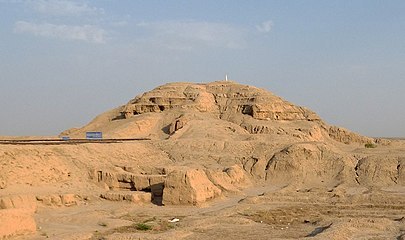
Some of the ruins of Uruk
Ishtar is most commonly seen as the daughter of Nanna/Sin and Ningal, making her the
sister of Šamaš. But in other myths she is the daughter of An the Sky or Enki. Her sister is
Ereškigal and like in FTF Ishtar did descend into the Underworld, but about that we will tell in the next post.
Ishtar/Inanna came to possess the me-s: divine norms of civilisation in the myth Inanna and
Enki Inanna travels from her own city of Uruk to Enki's city of Eridu, where she visits his
temple and starts up a drinking competition with Enki. Then, once Enki is thoroughly
intoxicated, Inanna persuades him to give her the me-s. Inanna then flees from Eridu, taking
the me-s back with her to her city, Uruk. After Enki realised what happened he sent “fierce
monsters” after her, but Inanna managed to return to Uruk. In the end Enki reconciles with
her and bids her a positive farewell.
The most famous spouse of Ishtar is Dumuzid/Tammuz the Shepherd god. About their
courting you can read this translation
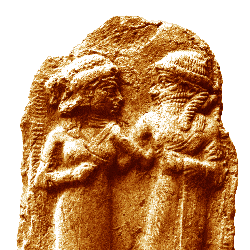
Depiction of Ishtar and Tammuz
Do you want to know more, you mage? See here:
link; link; link; link; link; link; link; link
21 notes
·
View notes
Text
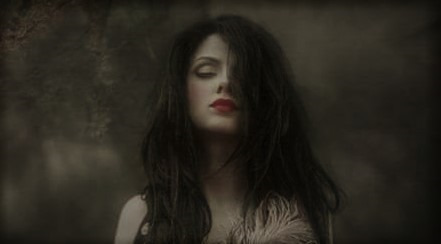
Ereshkigal
Mesopotamian goddess of death; Queen of the Underworld
Ereshkigal is the Queen of Kur (Akkadian: Irkalla), the Mesopotamian Underworld. Sometimes, her name is given as Irkalla (similar to how Pluto is often called Hades after his realm’s name) and other times she may be called Ninkigal, meaning "Lady of the Great Below". The land of the dead was believed to lie beneath the Mountains of Sunset and was also known as Kurnugia ('the Land of No Return'). Kur (Kurnagia) is an immense realm of gloom beneath the earth, where the souls of the weak dead are said to drink from muddy puddles and eat dust while strong souls drink from the river Eridan. Ereshkigal rules over these souls as their Queen. Her palace is called Ganzir, which is located at the entrance of Kur and is guarded by seven gates, all of which are watched over by her servant, Neti.
Myths: While Ereshkigal’s younger sister, Inanna, represents light and life and is the Queen of Heaven, Ereshkigal is darkness and death. These two sisters are rather like two sides of the same coin, and together, they bring balance. It is said that Ereshkigal ruled her realm alone until Nergal (god of war, plagues, and death) became her husband and her co-ruler for six months of the year. She is said to have fallen in love with him upon his visit to the Underworld, but he had to leave after a week. Wishing to remain with Ereshkigal, Nergal is able to return to her for six months of each year. The servants and throne-bearers of Ereshkigal are known as the gugallû/gallû. They are lethal entities who enforce divine wrath in the name of the goddess of death (though sometimes employed by Utu) and are described as sexless shapeshifters and harbingers of disease and despair. These terrifying beings were said to know neither food nor water, but drank blood and were the winds of storms.
Ereshkigal’s most well-known myth is the Descent of Inanna, which portrays her encounter with her sister. In this poem, the goddess Inanna descends into the Underworld and knocks loudly on the entrance to Kur, demanding entry. When Neti, the gatekeeper of Kur, hears this, he informs Ereshkigal that Inanna is at the gates. She then orders Neti to bolt the seven gates of Kur and tells him to have Inanna remove one article of clothing before she enters each gate. Upon going through all seven gates, Inanna then stands naked before the throne of Ereshkigal and bows to the Queen of the Dead. Suddenly, the annuna, the Judges of the Underworld, surround Inanna and pass judgment on her.
Ereshkigal then fastens on Inanna her Eye of Death and speaks against her the Word of Wrath. She utters against Inanna the Cry of Guilt and strikes her. Inanna is instantly killed, her corpse then hung from a hook on the wall. After three days and nights, Inanna's minister, Ninshubur, pleads for help from Enki, Inanna’s father. Enki agrees to rescue Inanna from the Underworld and sends two of his gallû down to revive Inanna with the food and water of life.
Appearance: Ereshkigal's appearance is that of darkly regal beauty. She is a pale woman in her late 30's with long, straight black hair, dark brown eyes, high cheek bones, and dignified features. She often wears a long, slender black dress that is very elegant. Ereshkigal’s kingdom of Kur/Irkalla is subterranean and features a solemn city of bones. It is very dark here, without any sun. Her palace is majestic and gloomy, made of polished black stone and sits tall at the back-centre of the kingdom. It is a very vast domain, but the Underworld itself is far more vast since it contains every kingdom of all the chthonic gods. Overall, the Underworld is a realm that is larger than the Earth itself.
Personality: Ereshkigal is mysterious, imposing, sophisticated, solemn, commanding, confident, and sometimes a bit sarcastic. She has a very dark demeanor and does not like to have her time wasted, especially when someone is not giving proper respect. Ereshkigal is also very dangerous when angered. Usually, she becomes icily cold when insulted or might even seem eerily amused by the person’s foolishness; but either way, such actions result in the goddess bringing severe punishment upon them. It is only when she is fully enraged that she might show more intense emotions in her fury, which always means a horrible death for those she targets. When she becomes like this, Ereshkigal’s appearance becomes even darker and she manifests twisting black horns on her head (like a ram’s, but the points are directed forwards). She may also show her face of Irkallu towards those who earn her ire; this appearance is so horrifying that any mortal who sees her quickly dies from terror.
Ereshkigal explains how the event with Inanna descending to her kingdom also happened, but it isn’t what humans have often assumed. Inanna was never seeking to claim the throne of the Underworld or betray her in any way. In truth, Inanna sought to transcend into further Illumination by conquering death and asked for assistance from Ereshkigal. After a ritual entry into Kur, Ereshkigal killed Inanna, and she remained dead for three days and nights. When she resurrected, Inanna ascended to a higher state of being.
Offerings: pomegranate juice, lime juice, absinthe, bitter hot chocolate, pomegranates, sour cherries, blackberries, blueberries, plums, limes, blood oranges, cob bread, beetroot, eggplant, artichokes, lamb meat, goat meat, rooster meat, king prawns, lobster, mussels, chestnuts, nutmeg, garlic, wheat, poppy seeds, purple pansies, henbane, belladonna, black dahlias, obsidian, jet, black onyx, malachite, animal bones, silver or gold jewelry with black crystals, silver chalices, silver platters, ornate scepters (with animal bone and wood), silver hand-held mirrors, midnight dahlia perfume, decorated fake human skulls, silver claw rings, obsidian mirrors, black candles, and incense of cardamom + poppy + violet
#ereškigal#ereshkigal#goddesses of death#chthonic gods#mesopotamian gods#sumerian polytheism#mesopotamian polytheism#deity work#religion
373 notes
·
View notes
Quote
Unequivocally astral names are used in the treaties that Esarhaddon concluded with the vassals of Assyria to secure the rights of succession of his son Assurbanipal; they were put under the protection of not only the major Gods Šamaš, Sin, and Ištar, who are elsewhere too identified with Sun, Moon, and the planet Venus, but also of other astral deities. Thus Jupiter introduces the list of six astral deities in Esarhaddon's Succession Treaty, the other five being Venus, Saturn, Mercury, Mars, and Sirius, in this order. Similarly, Jupiter precedes Sirius in another treaty which is known only from its mention in a letter of Esarhaddon's son Šamaš-šumu-ukīn. The treaties concluded in Anatolia between the kings of the Hittites and their neighbors some six hundred years earlier were also put under the protection of the planets and stars, particularly of Venus, called "resplendent Ištar (variant: Venus" as well as of the Storm God and such cosmic powers as mountains and rivers, and of the "Gods of the Nether World" for which a variant substitutes Ereškigal, the Queen of the Nether World. The appeal to Babylonian deities in Their astral manifestation can still be found in Syriac magic texts.
“Astral Magic in Babylonia” by Erica Reiner (p 18-9)
1 note
·
View note
Text
About my spiritual-religious system
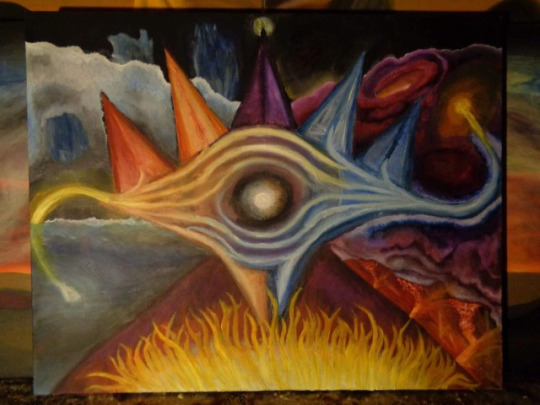
This spiritual-religious system involves some awesome gods and goddesses. Among them are Lilith Ereškigal, Aštoreth, Mikhael, Iblis Lucifer… and, most of all, YHVH. I helped create this Nexion with a primary purpose of establishing evolved and exciting interpretations of certain ancient Abrahamic and Mesopotamian deities. This is a new religion… born of ancient waters.
I have been most inspired by the majestic Middle-Eastern myths of Judaism, Christianity, Islam, and ancient Mesopotamia, but I am tied down to nothing. I have been without God(s), and I have been against God(s). In this moment I choose to embrace God(s)… but in my own way, through my own Weltanschauung, and in a manner that most reflects my own Will and goals and ambitions.
I have been inspired by Thelema. O9A. The Hermetic Order of the Golden Dawn. Ceremonial magick and traditional European witchcraft. Various forms of paganism. I absorb strength, power, wisdom and beauty whenever, wherever and however I Will. These things can be found in any religion, any culture, if one is of the mind to find them.
Though I am polytheistic, I worship YHVH above all else… as a Supreme God, and the ultimate force of Creation and Destruction, and ultimate Order over ultimate Chaos.
This is just a brief intro. Moving forward, more will be revealed in time. Ideas will flow here from the primordial waters of my interior universe, for others to drink from… or perhaps, for them to stare into, and watch as their own reflections transform before their eyes.
I am excited to see what becomes of things.
-Ashtara 3127
0 notes
Note
I was wondering, why did the Greeks associate Nanaya with Artemis? I keep reading about an "Artemis-Nanaia", but Nanaya doesn't really seem that similar to Artemis. Is there something that I'm missing?
Paul-Alain Beaulieu covered this in Nabû and Apollo: The Two Faces of Seleucid Religious Policy. Similarly as Nabu = Apollo, this seems to boil down to Seleucid royal ideology. The Seleucid dynasty considered Zeus, Apollo and Artemis their tutelary deities, and typically the local cults which were to receive royal patronage had to be equated with one of these. Zeus had the obvious parallel in Marduk, Nabu was his son so he got to be Apollo, and Nanaya was female and associated with Nabu which was a close enough match to warrant the Artemis equation. I fail to see any closer similarity, and I suspect it's down to chance that the Greeks picked her over Tashmetum.
Joan Goodnick Westenholz argued a factor might have been depictions of Nanaya with a bow (source), but these are late and while it is not impossible they are a strictly Mesopotamian development, with Nanaya being representedin a way well documented for Ishtar earlier on, it might as well be the result of the Seleucid policy resulting in the borrowing of iconography of their favored deities from coins and the like for local ones.
I might be wrong but I think the only Greco-Roman author to offer a different take on Nanaya is Appian of Alexandria, assuming that is who he means by "Aphrodite of Elymais" (there was a temple of Nanaya in Susa in late antiquity, but I'm pretty sure she didn't even appear in theophoric names there for most of her history). Nanaya's generally non-astral character does not make her perfect match, but this feels more justified than many Greek assertions that foreign deities correspond to Aphrodite. I would boldly suggest it's more justified than the Ishtar = Aphrodite claims, seeing as Nanaya generally lacked a warlike aspect, and Aphrodite was not exactly a deity commonly invoked by kings during campaigns, a mainstay of Ishtar devotion through solid 2000 years.
The Greek-Mesopotamian interactions under the Seleucids, as well as the state of Mesopotamian religion in this period, are discussed in some detail in Julia Krul's The Revival of the Anu Cult and the Nocturnal Fire Ceremony at Late Babylonian Uruk, if you want more historical context. On the matter of Greek familiarity with Mesopotamian deities see Beyond Ereškigal? Mesopotamian Magic Traditions in the Papyri Graecae Magicae by Daniel Schwemer.
The presumably Seleucid Nanaya-Artemis connection left a trace in the further history of Nanaya, but that's a topic for another time; I will be working on a related wiki article next month so feel free to ask about that if it's of interest to you though.
As a final curiosity it's worth noting equations between Nanaya and foreign deities were not exactly common in the Bronze Age: the recently discovered Amorite-Akkadian bilingual has her as the counterpart of Pidray (otherwise only known from Ugarit but presumably originally linked to Aleppo), and Frans Wiggermann maintains an equation between her and Elamite Narundi was a thing, but he doesn't cite a source and also by the time it would've occurred Narundi was only worshiped in Mesopotamia anyway.
13 notes
·
View notes
Text
Prayer Beads
To Help My Brain Fog Worship Road Block

Left to right
Purple— Health Theoi & Diĝirene
Red— Education/Goal oriented Theoi & Diĝirene
Blue— My Queen Ereškigal and Co.
Beige— Hellenic Oikos Theoi
White— Mary, Our Lady of Sorrows (Rosary)
I noticed its so much easier to invoke the Gods after taking my meds when the little prayer bead bag is right there. Its like a little alert for my brain to remember; which I might not remember to without the little alert.
I'm not sure where to put the others yet. Except Oikos one I know where it is going. As for the others they might all stay in the same location and I can take one through out the day— on days when I have the emotional energy to focus on my Gods for a few moments that is; which is not most days but these may help that.
The prayer is literally saying their name at each bead (for now) and I may add something else if I want, along with the ending of "sweet is your praise." The health deities sometimes have more than just their name like "Epione, soother of pain." But I've been using the health one for awhile so I've 'figured out' how best to use it; the others I haven't yet.
This is all except the rosary of course, I'm still working on that, I got it today and its so much larger than I realized.
10 notes
·
View notes
Text
My Religious Name
-repost written long ago but with significant editing and additions-
I've decided on a religious name for myself: IzkurEreškigal.
Written in cuneiform as:
𒄑𒆳𒀭𒊩𒌆𒆠𒃲
In Mesopotamia theophoric names were standard, and usually it was just shoving the whole name with something else for example, Ur-Nammu which means “Servant of Nammu.”
I worked hard to find a name, there were many options. With the help of personal meaning, prayer, and setting up an altar to Ereškigal I discovered this name was best.
In various sources I have found the name ‘Izkur[Deity Name].” Based on those sources it translates to “[Deity Name] has called.”
Experience with Ereškigal
It's not very common to experience UPG with Ereškigal compared to some other Diĝir/Theos but when I do experience it... it is very loud. Ereškigal is the reason I am a Sumerian Revivalist. (I worshiped Inana in eclectic pagan / polytheist days but it never led me to Sumerian Polytheism)
Thus there is symbolism in terms of callings. “Ereshkigal has called.” She didn't call in the sense that she "called me to worship her" or that she "chose me". I chose to give her honor one night on my own. When I approached her and asked for her help she gave it to me and after the first time I honored her she called to me to continue doing so. Figuratively inviting me to worship this pantheon along side her. She gave me the loudest "god phone" I've ever experienced with very intense melam and full of ni. Shes why I worship the Diĝirene, and via some UPG she is my "personal Goddess" in the Sumerian context. She is My Queen and I am her devotee.
Name Sources
Side note: while I am Sumerian in practice the name comes from the Akkadian language.
“List of Persona Names From The Temple School of Nippur: A Syllabary of Personal Names" by Edward Chiera. University of Pennsylvania: The University Museum Publications of the Babylonian Section. Volume 11, no. 3. 1916.
This gives 3 different examples of "Deity has called" as a name:
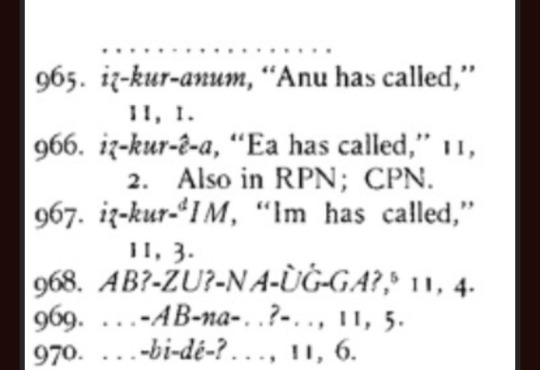
From “Personal Names from Cuneiform Inscriptions of the Cassite Period" by Albert Tobias Clay. Volume 41, Yale University Press, 1912.
The second source gives “Iz-kur” with many other deity names. It doesn't translate it, it just shows that it was a name:

Early Babylonian Names: The Published Tablets of the So Called Hammurabi Dynasty by Hermann Ranet. University of Pennsylvania 1905.
Izkur is translated as "he called by name" and the example Izkur-Ea is given:


11 notes
·
View notes
Note
what is the best way to find real, genuine, information on various Deities? and, besides intuition, how can we know this info is true?
By vetting sources
Look for authors in the field that studies those ancient societies & religions (well if they are ancient and ""dead"") not random neo-pagan website that cite nothing. Pay attention to the age of the source and see if there are any other sources that agree or disagree with the claims. You can certainly use blogs & websites for modern pagans/polytheists but its about where they get their info and if they provide or are willing to provide sources.
Use the CITATIONS found on the wikipedia page of the deity and vet them to see if the info is reliable.
Internet Archive is your friend you simply need a free account and you can borrow books including old ones that have been scanned in.
JSTOR allows you to read 100 articles per month also with a free account.
Academia.edu is also useful and has a free version, again vet sources, especially authors for this website
Deepdyve is a website that isn't free but it isn't outrageously expensive for what it offers. If you have the spare money to put into this. Its how I found the article about Ereškigal and her throne or lack there of and also Mesopotamian household deities.
I also have this small post for info on Greek & Mesopotamian deities. I don't really rely on intuition when finding & vetting sources, thats more so what I do in my practice with the information I've learned.
Hope this helps 🤍
11 notes
·
View notes
Note
Hi! recently the sumerian deities / faith has been intriguing me a lot. your blog has been a huge help for me so far in my research. while searching I found out that the God Abzu wasn't really worshipped by ancient Mesopotamians (I don't think any temples for Him were ever found?). I was wondering what your opinion would be if someone started to worship Him like other deities in this faith? I'm just very curious of your answer!
Hi, very very sorry for the very long wait.
Sometimes when it comes to certain deities you just have to go on UPG (or "feelings" if UPG is uncommon like it often is for me) since information is scarce or Assyriologists don't agree with each other
For disagreement some examples:
Ninlil I've seen two Assyriologists call her an artificial God meanwhile another source claims she had her very own temple.
Ereškigal I've seen one Assyriologist claim she had no temples or worship, one claim she had no major cult but was definitely honored in temples, another claim she had her own small temples, and yet another claim she had a cult festival.
An example closer to this Abzu conundrum is Gugal-ana. I can't fine any information on him if he was worshipped in any temples, if he has any literature beyond Inana's Descent, or if he was ever given offerings. I've seen one Assyriologist claim it could be another name for Nergal and a different Assyriologist claim he was potentially Enlil in a pre-Early Dynastic period pantheon and he had to be "cloaked/separated" when Enlil's role in the pantheon changed; [EDIT, I honestly don't know which one is more likely so I retract this opinion, the latter seems more substantiated in my opinion.]
What's important from the last one, that pertains to your question: UPG steps in and tells me it's okay to worship him. My mind ponders him being the possible underworld aspect of Enlil, but for now I should worship him as Gugal-ana plain and simple. Unless I manage to find more resources and they help shape or change my view of him.
But is he a God at all?
Like Gugal-ana, Apsû appears in a singular myth (as an anthropomorphic "deity"), and no others that I know of. Unlike Gugal-ana neither Tiamat nor Apsû have the divine determiner in their name, which means it is truly unlikely they were ever worshipped but that doesn't stop a lot of people today from choosing to worship Tiāmat.
Things to consider:
The Abzu/Apsû was home of Enki/Ea
The god Ea (whose Sumerian equivalent was Enki) is one of the three most powerful gods in the Mesopotamian pantheon, along with Anu and Enlil. He resides in the ocean underneath the earth called the abzu (Akkadian apsû), which was an important place in Mesopotamian cosmic geography. For example, the city of Babylon was said to have been built on top of the abzu (Enki's Oracc page)
In Myth Ea kills (or makes sleep) the anthropomorphic Apsû and builds his house on him
Even his anthropomorphic form lacks the divine determiner in the textual source
Abzu(s) were basins of holy water in temples
All of this combined shows it is highly unlikely that he had any historical worship
If you are going off UPG consider whether or not you're actually interested in (or I suppose they're interested in you) deities of the Abzu: Enki, Damgalnuna, Namma, Isimud, potentially others like Enki's children.
With Abzu/Apsû question yourself, does it feel right to worship him? If yes then I suggest:
Make a small space with a representation of him such as a bowl of clean water
Have either a candle or incense to light for him
Say a small prayer to him while introducing yourself at the beginning. Mesopotamian prayers consist of praising the deity, asking supplication, and this is how they usually end. Additionally they are often repetitive saying things 3 times sometimes verbatim sometimes the same thing said differently.
You could also do a libation or an offering.
IF you have to remain in the closet I suggest a sink libation with a small & quick prayer of praise.
If you do these things and it feels comfortable then it seems natural to continue worshipping him if you want. You'll have to make your own prayers and such since there is no ancient materials available. His worship would be essentially a modern invention but modern does not equal bad if we recognize and accept its modernity.
Abzu/Apsû Information
From Oracc:
The abzu (Sumerian form) or apsû (Akkadian form) was a large underground body of water in Mesopotamian cosmic geography. It was the domain of the god Enki/Ea. The city of Babylon was said to have been built on top of the abzu, and the Sumerian myth Enki and Ninhursag describes that the first humans were created from clay taken from the top of the abzu.
From Gods Demons & Symbols of Ancient Mesopotamia by Jeremy Black & Antony Green:
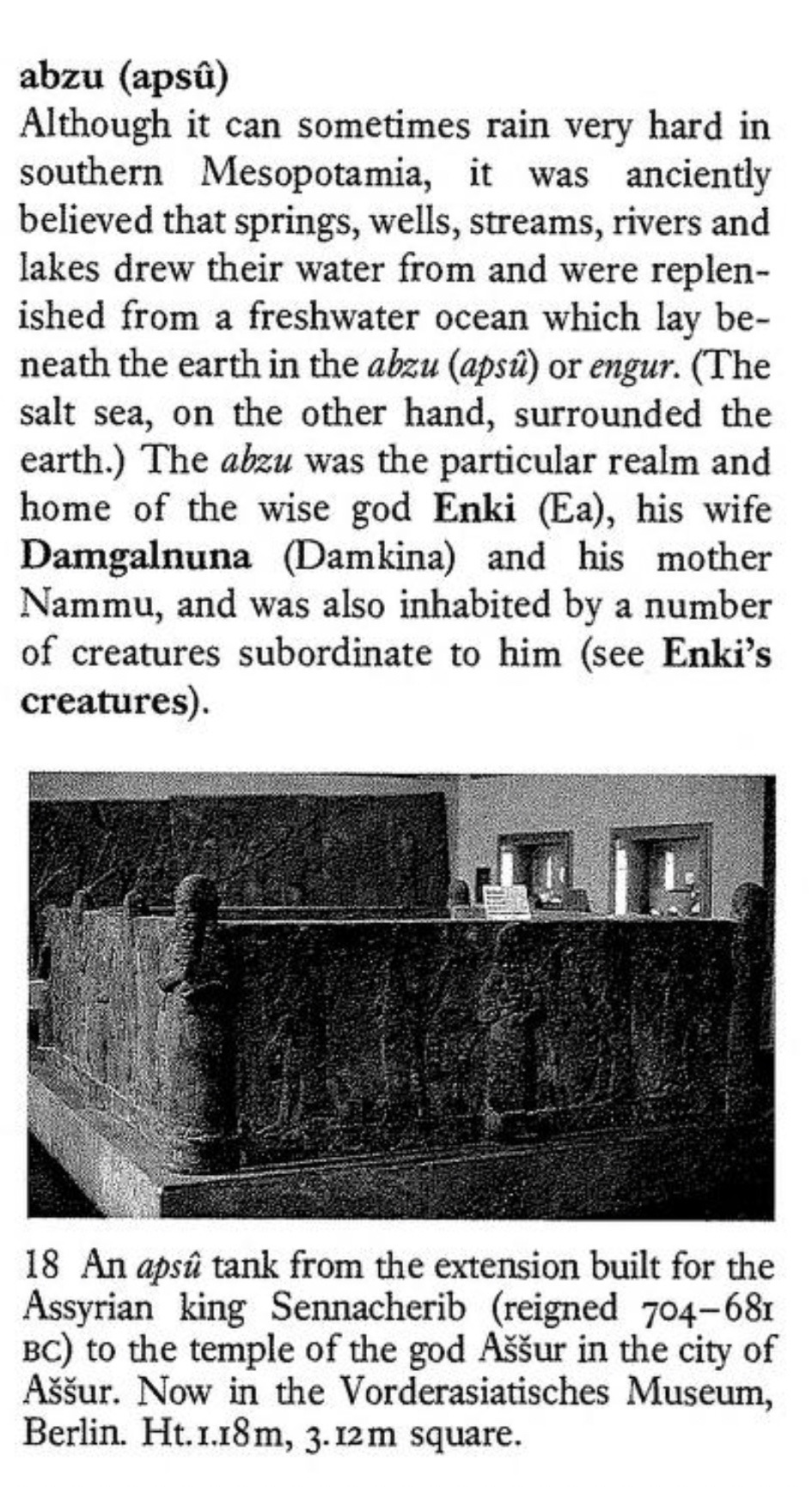
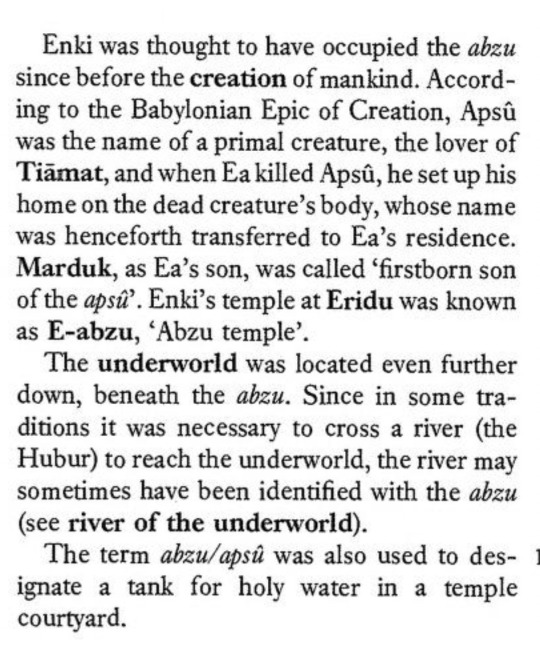
From A Dictionary of Ancient Near Eastern Mythology by Gwendolyn Leick:
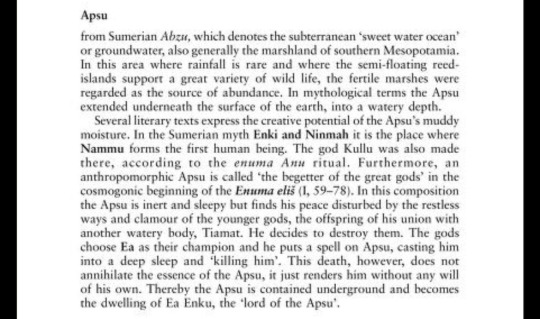

From A Handbook of Gods and Goddesses of the Ancient Near East by Douglas R Frayne and Johanna H Stuckey:


From Bad King, False King, True King: Apsû and His Heirs by Karen Sonik X or JSTOR (you can get I think 100 articles free per month):
The problem of accurately pinpointing Apsû’s role and identity within Enuma elis, whether as monster or personified or deified subterranean waters, springs both from the shifting nature of his depiction in the narrative and from the writing of his name therein, which never includes the divine determinative that marks the gods proper within the text. Portrayed as an elemental entity at the opening of the epic as he mingles his waters with those of Tiamat, Apsû does not remain such for long. Once the first gods are generated from his intercourse with Tiamat, beginning the process of differentiation, Apsû himself seems to morph into a sort of proto-god, still not endowed with the dingir-determinative but newly provided with anthropomorphic features and with insignia reflecting his new rank and status: He is given both a voice and a mouth with which to speak (Ee I 35–36); a more or less anthropomorphic physical form (I 53–54), clothing or insignia including at least an agû, crown; and possibly also a riksu, sash or tie (I 67); melammu (I 68); and a rudimentary household of the type standard for the great gods, though here simply comprising his vizier or counselor Mummu (I 30–31). On the subject of Aprû’s state of dress, it is worth reiterating the association of clothing with life in Mesopotamian literature, specifically with civilized life. Thus, in well-known episodes from the SB Epic of Gilgames, Enkidu dons clothing as the second step in his transformation from wild proto-man to civilized man of the city (Gilg. SB II 34–35), while Gilgames, who dresses in lion skins during his wanderings in the wild, again dons his clean royal finery before returning to human civilization (XI 250–70). In the case of Apsû, his assumption of the agû may similarly signify his transformation into a more civilized and active entity, the direct result of his contribution to the differentiation and organization of the world through the generation of the gods.
From The Tablet of Destinies and the Transmission of Power in Enūma eliš by Karen Sonik X:
The opening lines of the epic describe the mingling of two primordial and el- emental entities, Apsû and Tiāmat, who generate the first gods and who seem to evolve thereby into active proto-deities, complete with at least semi-anthropomor- phic forms and divine powers and attributes. As the parents of all the gods, Apsû and Tiāmat may also be read as the first rulers of the text, legitimately endowed with divine authority over the gods. Apsû, as befits a king, stands at the head of a line of legitimate heirs, among them Lahmu and Lahamu, Anšar and Kišar, Anu, Ea, and ultimately Marduk, who comprise the great gods. He is also the apparent progenitor of a mass of unnamed and undifferentiated descendents, who comprise the lesser gods. Legitimate power, so far, is relatively concentrated: it is located in the hands of Apsû and Tiāmat and their rightful heirs. This situation, however, does not last. [Footnote 6] Apsû and Tiāmat are not gods proper as has sometimes been suggested, ibid. Their names, unlike those of the rest of the gods in Enūma eliš, are never written with the divine determinative (Anšar alone is excepted, as his name begins with the dingir sign). Following the generation of the first gods from the mingling of their waters, however, Apsû and Tiāmat do seem to evolve into proto-deities, possibly as a result of the civilizing qualities of sexual intercourse [...] [Footnote 7] Whether he is to be understood as the first king or ruler, Apsû is certainly the first major male authority figure to appear in Enūma eliš by virtue of his position as the father of all the gods. (Page 388)
I hope this helps, and again sorry its so late
-not audio proof read-
11 notes
·
View notes
Text
🏺Gods & Spirits🏺
That I worship in my practices.
I worship all Theoi (Greek) & Diĝirene (Sumerian) I may also honor other spirits or "lesser Gods" in both cultures. Since many pagans & polytheists list their Gods in a bio I thought I'd put together my own lil' list.
For resources on deity information go to this post.
Sumerian deity names in posts are spelled using the ETCSL's proper noun list. However, I may add the other spellings in a post and won't change spelling in direct quotes.
I'm going to cut this since it'll change over time.
My view on the existence of other Gods.
In brackets [] is the translation of an epithet
I have 3 distinct practices Hellenic & Sumerian Polytheist Revivalism (as one whole); Shinto; Maryolatry. I may worship or honor other spirits but those are my practices.
I'll list the ones that often have spots on my Altars & Shrines and then a few I think also deserve mention.
🔶 Devoted To
⚫️ Ereškigal — My personal God in context of Sumerian tradition.
Ereškigal is My Queen, Ninĝu Ereškigalam, 𒎏𒈬𒀭𒊩𒌆𒆠𒃲𒀀𒀭
I always address her as My Queen, Ninĝu, 𒎏𒈬
Namtar her son & sukkal is worshipped due to their relation.
Gugal-ana her husband worshipped due to their relationship and upg.
⚫️ The Sun — The sun has always been important to me. Since the beginning of my path in polytheism.
I sometimes worship "The Sun", as a creator and life giver.
If I worship a specific solar deity it is only ever Amaterasu-Ōmikami-Sama in Shinto tradition.
If I am worshipping another solar deity, such as Apollo & Utu. I deliberately do not worship them in their solar aspect.
🔶 Close to My Life
Athena Ergane [Worker] — I have dedicated my education to Athena since high school. I also fully believe she has been with me my whole life and witnessed my birth.
Nanše — This comes specifically from Hymn To Nanše Lines 20-31
Nanaya — Gender Identity / LGBTQ issues
Hera Antheia
Ares | Laossoos [He Who Rallies Men]
Ninĝirsu | Ursaĝ [Hero]
🔶 Health
Ninisina Gula [Great]
Damu
Asklepios
The Asklepiades:
Epione
Hygeia
Akeso
Iaso
Panakeia
Aigle
🔶 Household Gods
This is loosely based on ancient Greek tradition (Attic) a concept I found via modern Hellenic Religious group Labrys.
Hestia
Zeus Ktesios [of the House]
Zeus Herkeios [of the Fence]
Apollo Agyieus [of the Street]
Hekate
Hermes
Hera Oikos [of Household]
🔶 Various Other Reasons
For me worshipping a Diĝir, Daimon(a), or Theos on my altars or shrines only requires a identifiable reasons. No interpersonal relationship, calling, communication etc necessary. If I have a reason in mind then they might get a spot on a shrine or altar.
Enlil
Ninlil
Enki
Inana
Dumuzid
Ĝeštinana
Ningirim
Gibil
Apollo Proopsios [Foreseeing]
Gunida Nisaba [Hulled Grain]
Geštug Nisaba [Wisdom]
Nanna
Nirah — Purification. Temple protection at Enlil's E-kur which was among the most important Sumerian temples thus he represents altars to me, also a ritual protector. I believe there are other Nirah(s) but I'm specifically speaking of the one in the E-kur temple
🔶 Gods not represented on Shrines
That still deserve a mention, due to importance I place on them or how often I invoke them:
An — Sky & Heaven and most supreme in Sumerian pantheon. His cuneiform is "Diĝir" the divine marker for deity names. One of my devotional necklaces to represent me as a Sumerian polytheist is a pendant with that sign.
Hypnos
Mamud
Uraš & Gaia — The Earth (No, I'm not choosing one or the other)
Rheia — as Mêtêr Theon (Mother of The Gods)
Namma — as Amadiĝirdiĝira (Mother of The Gods)
Zeus Patér [Father]
Hera Mêtêr [Mother]
Apollo Paian [Healer]
Athena Paionia [Healer]
⛩Shinto Kami
Kami is not a direct translation to "God/Deity" it depends on context. I personally believe the two Amatsukami 天津神 I worship are "Gods," being among the highest beings in my spirituality. They have their own Kamidana separate from my other practices. Here is some information on Shinto for better understanding.
I worship in a home setting:
Amaterasu-Ōmikami 天照大神
Ame-No-Uzume-No-Mikoto 天鈿女命
⚫️ Additional
Our Lady of Sorrows — (Catholic Saint) primary aspect of the Virgin Mary I worship in what I refer to as Maryolatry.
Nuestra Señora de la Altagracia — (Catholic Saint) Our Lady of Altagracia, the Virgin Mary as protector & spiritual mother of the Dominican People.
Guabancex — (Taino Zemi) It is silent & important recognition of her power not an active honor/worship.
#hellenic polytheism#polytheism#paganism#deities#ofthetheoi#landof2rivers#mypractice#i have taino ancestry
27 notes
·
View notes
Note
8 and 13 (I know you’ve said it’s scaled back, curious what you’re currently doing 😊)
8. What are some of your stronger UPG’s
Hm, I guess it depends on what you mean by strong.
When I have and UPG from Hygeia she's kind of a "I don't take shit. Do it." attitude— very stern; but its about little things, primarily her idol's condition.
In terms of strongest experience definitely Ereškigal but I won't share.
In terms of, 'I am absolutely certain this is true', its that Athena likes coffee
More on me and UPG
13. What are some devotional acts you actively engage in?
Honestly right now I'm having trouble just being religious, kind of explained here.
But in general:
I've become more attentive to invoking the God I dedicated a "TV" show to when I start watching it. I used to forgot to often. (examples)
I'm trying to do sink libations more often.
I want to print out my Asklepiades sheet, or a edited version, and post it next to my medications so I remember to invoke them more often.
With my altar and shrines set back up I can now do my deity name recitations easier which is nice. (I had a post on that on my old blog but I don't think its been reposted)
Invoking just means saying a Gods name while sincerely thinking about them.
For feeling less confident in the validity of my religion somehow my practice in general seems to have increased... not entirely sure why. Maybe its me reaching out? Or maybe I just have slightly more energy.
-not audio proof read-
2 notes
·
View notes
Text
Adventures with my new dictionary:
I cannot use this efficiently I'll be looking for something specific but OHHH WHAT DID THAT SAY THAT LOOKS INTERESTING *gets distracted from goal for a hour* Like a dog getting distracted by a squirrel.
This dictionary doesn't have header words (like ya know how itll have the first word listed on the page on one side and the last on the other or whatever, I don't know what thats called)
Ereškigal had a 2 day festival AND it gives a depiction of her which I thought we had none. Shes got two snakes in it!
I also took too long to find Ereškigal because of alphabetic fuckery and started to get super depressed because she was left out , nope not the case.
"Deity equated with", "another name for", "probably the same deity as" ....... dear lord Ancient Near East. My equating vs separating deity post needs some uhhhhh updates. That post will never get done 😩
7 who decree is a thing! at least in one temple and just not at all what modern recon sumerians tout it as. Will have to add that to the post which i havent reposted.... if i can find the dictionary entry again possibly lost
Nin-gir-zida is a Mesopotamian goddess whos name means "Lady of the Trusted Knife" just an fyi
This book. Has. 36 pages. Of bibliography and I need to translate this jumble of numbers and words (photo) at the end of each entry into a concrete bibliography entry which will probably be one hell of a headache..... getting access to the source once i figure it out will probably be impossible because yay paywalls
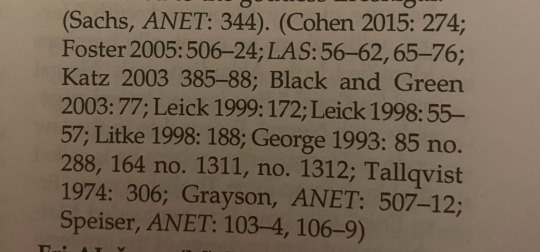
#landof2rivers#i love it#do i desire to read 372 pages of a dictionary? yes#can i ?#unlikely#will i still try?#eventually#just depends do i read this or leick first#i got side tracked from taking night meds and going to bed for almost 2 hours#damnit book
2 notes
·
View notes
Text
2am ramblings on "Never Truly Hers: Ereškigal’s Dowry and the Rulership of the Netherworld"
by Gadotti, Alhena in Journal of Ancient Near Eastern Religions , Volume 20 (1): 16 – Jun 18, 2020
Academic: Ereškigal has no actual cult in Mesopotamia
Also Academic: Except for temple's dedication to her in Assur, Kutha, and Umma. This contrasts with Nergal's vital cult
Isn't this a contradiction? Its basically saying "because she had no city cults as vital as Nergal's that means she had no cult....except in these places that I mentioned but just forget they exist" Like not all Mesopotamian deities had a city-large cult? That doesn't mean they had no cult. In fact, there are three scholars who disagree (Leick, Frayne & Stuckey) and the second two even mention a festival in her honor. And WHY would any literary composition give Ereškigal it's ending praise if she had no cult at all?

I cannot find a peer review article on this article and I really really want one.
Critiquing the idea that Ereškigal & Nergal was written specifically to unionize two desperate views of the underworld is great and a very compelling argument. But jumping to the conclusion that Ereškigal never held the underworld as hers to begin with in any Mesopotamian tradition because of the word "saĝ-rig(7)" in one copy of the myth "Gilgameš, Enkidu, and the Underworld" seems off? Or I could just be dumb, hence wanting another academic's view not my own conclusions.
She even openly says a few things:
Diana Katz suggests "in her lengthy study" that Enlil may have been Ereškigal's husband in a much older tradition. They conveniently never mention this again despite the ending mentioning Ereškigal's possible husbands: Gugal-ana, Ninazu, and Nergal— why leave out Katz assertion without giving a reason to ignore it? She even mentions that Namtar is Ereškigal's son with Enlil
That whatever happened in the "Early Dynastic Period is murky" but she still concludes that this literary analysis means she only held Kur as dowry even in those earlier times?
She mention family law in her interpretation of this but I find it so lacking because family law is known to be extremely different in different time periods (e.g veiling & inheritance) and she is drawing inferences from Ur III up to the Neo-Assyrian period for her persuasive argument. But she just says "Mesopotamian customs"....I'm sad that we didn't get actual quotes of marriage laws here or citations to the actual legal codes. Since it seems like a point she hinged her argument on and I'd be extremely interested
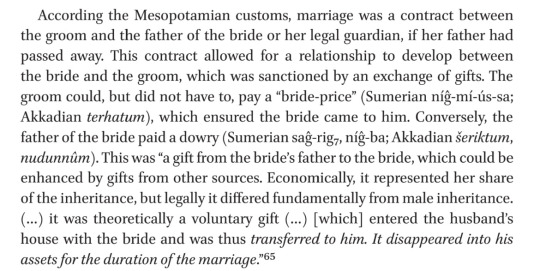

I am not saying I am smarter that her, or know more, of course I don't. But the article seems like it takes a lot of leaps and thats why I want another academic's published review of the article but I can't find any.
I also now need to find this Sladek guy's stuff because oh boy is this a claim. Also I think I read another thing that doubts Gugal-ana's bull stuff entirely—
why do Assyriologists contradict each other so much 😩
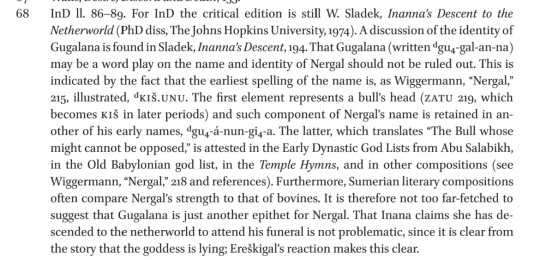
I also really need to deep dive into Katz material, especially that "lengthy study", but I always forget.
-not proof read-
Edit
Found quote from Katz argument in "The Image of the Netherworld in the Sumerian Sources"
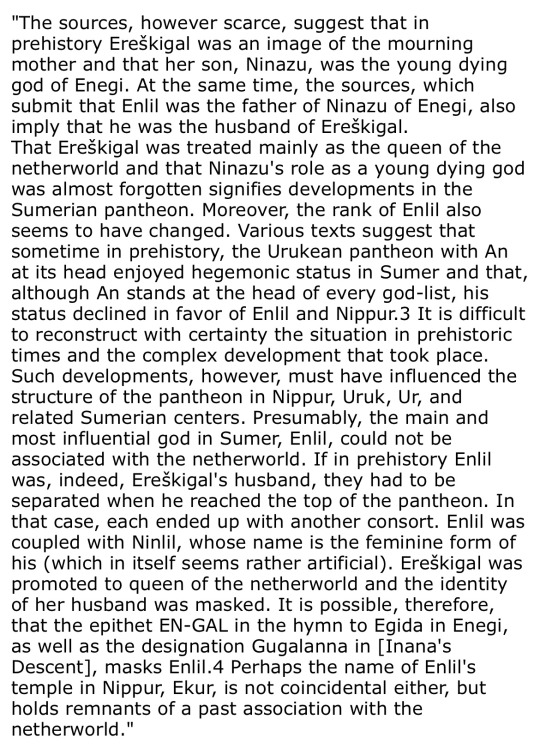
Don't have full text yet
Also another example of academics disagreeing because I'm forgetting what source but it mentions a temple to Ninlil and thus not an artificial deity
Urukean sounds funny
I could be entirely wrong, I'm just a bit confused due to academics concluding different things
0 notes